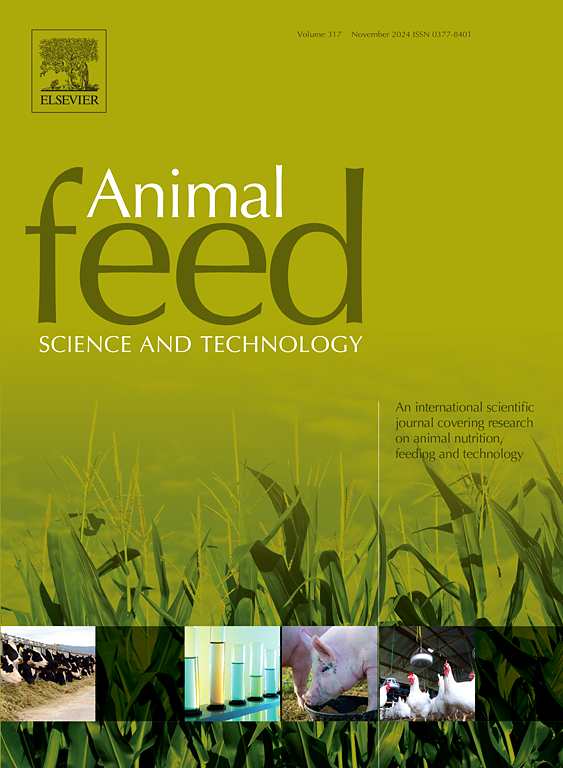Dose-dependent effects of supplemental phytase on ileal and total tract digestibility of nutrients and growth performance in growing pigs
IF 2.5
2区 农林科学
Q1 AGRICULTURE, DAIRY & ANIMAL SCIENCE
引用次数: 0
Abstract
The objective of this study was to determine the dose-dependent effects of supplemental phytase on ileal and fecal digestibility and hindgut disappearance (HD) of nutrients and growth performance in pigs. In experiment 1, twelve barrows with an initial body weight of 29.2 kg (standard deviation = 2.2) were allotted to 6 diets in a replicated 6 × 4 incomplete Latin square design to obtain 8 observations per dietary treatment. The coefficient of apparent ileal digestibility (CAID) and apparent total tract digestibility (CATTD) of nutrients were determined. Additionally, the HD was calculated as the deviation between CAID and CATTD. A high-phosphorus (HP; 5.1 g/kg total phosphorus) diet was prepared based on corn and soybean meal with dicalcium phosphate to meet the phosphorus requirement. Five additional diets mainly consisted of corn and soybean meal were formulated to contain a low phosphorus (LP; 3.8 g/kg total phosphorus) concentration. The LP diet was supplemented with phytase at 0, 300, 600, 900, or 1500 unit/kg. All experimental diets contained 5.0 g/kg of chromic oxide as an indigestible index. In experiment 2, two hundred forty barrows with an initial body weight of 29.5 kg (standard deviation = 2.4) were allotted to 1 of 6 diets in a randomized complete block design with 10 replicate pens per dietary treatment and 4 barrows per pen. The same experimental diets as in experiment 1 were provided to the pigs for 28 days. In experiment 1, the CAID, CATTD, and HD of dry matter was not affected but CAID and CATTD of calcium increased linearly (P < 0.05) with increasing phytase supplementation. The CAID, CATTD, and coefficients of standardized ileal and total tract digestibility of phosphorus increased (P < 0.01) in a quadratic manner with increasing supplemental phytase. The standardized HD of phosphorus was greater (P = 0.049) in pigs fed the LP diet compared with that in pigs fed the HP diet. Supplemental phytase resulted in a quadratic increase (P < 0.05) in CAID of all indispensable amino acids except methionine and tryptophan. In experiment 2, the growth performance was decreased (P < 0.05) in pigs fed the LP diet compared with those fed the HP diet but increased (P < 0.05) in a quadratic manner by supplemental phytase. In conclusion, the digestibility of calcium, phosphorus, and amino acids, and the growth performance of pigs were improved by supplemental phytase.
求助全文
约1分钟内获得全文
求助全文
来源期刊

Animal Feed Science and Technology
农林科学-奶制品与动物科学
CiteScore
6.00
自引率
6.20%
发文量
266
审稿时长
3 months
期刊介绍:
Animal Feed Science and Technology is a unique journal publishing scientific papers of international interest focusing on animal feeds and their feeding.
Papers describing research on feed for ruminants and non-ruminants, including poultry, horses, companion animals and aquatic animals, are welcome.
The journal covers the following areas:
Nutritive value of feeds (e.g., assessment, improvement)
Methods of conserving and processing feeds that affect their nutritional value
Agronomic and climatic factors influencing the nutritive value of feeds
Utilization of feeds and the improvement of such
Metabolic, production, reproduction and health responses, as well as potential environmental impacts, of diet inputs and feed technologies (e.g., feeds, feed additives, feed components, mycotoxins)
Mathematical models relating directly to animal-feed interactions
Analytical and experimental methods for feed evaluation
Environmental impacts of feed technologies in animal production.
 求助内容:
求助内容: 应助结果提醒方式:
应助结果提醒方式:


